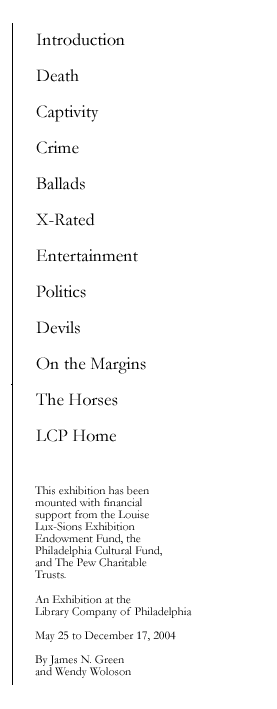

Murder was so uncommon in early America that each case raised uneasy questions about the true moral state of the community. By providing gory details of the crime and the testimony of the criminal and witnesses, published accounts of murder trials helped people digest these horrorsand reassured them that justice had been done. Broadsides supposedly reporting the “last words and dying speech” of the criminal were sometimes sold at the execution while the ink was still wet. They were an integral part of the public spectacle, which was designed to reassure people that their community had been purged of evil. They revealed what even the spectators could not see, the state of mind of the criminal just as he was about to be launched into eternity on the gallows.
Last Words and Dying Speech of Samuel Smith, who was executed at Concord … for the Crime of Burglary. [Boston: Printed by B. Edes], to be sold at Mr. Reuben Bryant’s book-store, Concord, 1799.
The condemned man recounts his life of crime, placing most of the blame on wanton women and other criminals, whom he identifies by name in the hope that they will be dealt with according to law. He was a failure as a burglar, but seems to have had great success as a counterfeiter. He keeps repentance to a bare minimum in this compelling true crime narrative.
[Isaac Bickerstaff?] The Life and Adventures of Ambrose Gwinett. Norwich: John Trumbull, 1784.
Gwinett was hanged for murdering a man in an inn, even though the body was never found. He was left for dead on the gallows, but he luckily revived and was spirited away by his brother. He escaped to the West Indies but was captured by Spaniards and taken to Havana, where he met the man he was supposed to have murdered. Later he became a notorious pirate, a galley slave, an Algerine captive, and finally a one-legged beggar on the streets of London. This classic adventure autobiography was first published in England and reprinted in America ten times. It is now thought to be fictitious.
The Last Words and Dying Speech of Levi Ames, who was executed at Boston … for Burglary. Boston: Printed and sold at the shop opposite the Court-House, 1773.
Levi Ames was perhaps the most written-about criminal in colonial America. His execution called forth two editions of these “Last Words,” four sermons in a total of seven editions, and no fewer than ten broadside poems. What was so special about him? That he turned to Jesus in jail? Otherwise this long list of the people he robbed is rather dull. Perhaps people bought it to see if they were among his victims, for he remembered almost all their names. His professional advice from the edge of the grave: “keep your doors and windows shut on evenings [and] do not leave linnens or clothes out at night.”
Cotton Mather. The sad effects of sin. A true relation of the murder committed by David Wallis, on his companion Benjamin Stolwood … With his … confession and dying speech at the place of execution. Boston: J. Allen, 1713.
This is only the second “confession and dying speech” of a murderer printed in America. The crime was committed on a ship in Boston harbor. Wallis was angry because he was hungry and dinner wasn’t ready yet, so he killed the cook.
Narrative of the life and dying speech of John Ryer, who was executed at White-Plains … for the murder of Dr. Isaac Smith, deputy-sheriff. [New York:] for the flying-stationers, [1793].
A Revolutionary veteran on the Tory side, Ryer was guilty of “excess drinking, card-playing, cock-fighting, cursing, swearing, together with almost every kind of vice, wickedness and debauchery.” He shot the sheriff while resisting arrest in a tavern.
Whiting Sweeting. A remarkable narrative of Whiting Sweeting; who was executed at Albany … for murder.Exeter [N.H.]: H. Ranlet, 1793.
This is probably the most frequently reprinted murder pamphlet in American criminal history, with at least a dozen editions. The main interest in the story seems to have been the severe penalty for an unpremeditated murder. A small posse was pursuing Sweeting to serve a warrant for trespass. Cornered in the woods at night, he lashed out at his pursuers and struck one of them with a knife, inflicting a deadly wound.
Isaac Frasier. A brief account of the life, and abominable thefts, of the notorious Isaac Frasier … penned from his own mouth, and signed by him, a few days before his execution. New Haven: T. & S. Green, [1768].
Frasier committed innumerable petty thefts, and was caught every time, yet only occasionally did the authorities succeed in punishing him. Usually he escaped from jail and moved on to the next town. Why he was finally condemned to death is not clear, but that last time he did not get away. He was 28.
Stephen Mix Mitchell. A narrative of the life of William Beadle … The particulars of the “horrid massacre” of himself and family. Hartford: B. Webster, 1783.
Beadle, a rich merchant, was slowly being ruined by post-war deflation, but he managed to keep up appearances, all the while plotting to kill his wife and children. He reasoned they would be unable to survive without him after he committed suicide, which was the logical response to the horror of downward social mobility. The insane rationality of the killer and the description of the bloody scene are worthy of Stephen King. So is the account of the attempts to dispose of Beadle’s body, which could not be buried in the churchyard, which no one wanted on his land, and which boys kept digging up.
